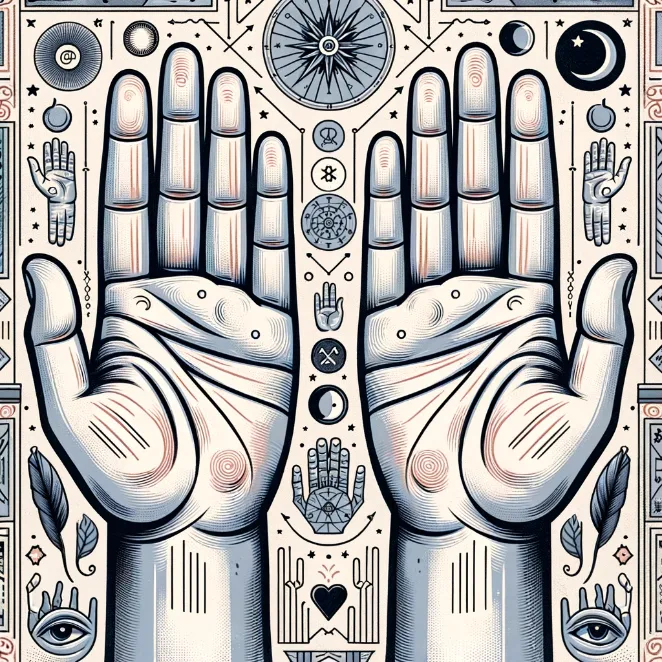
Palmistry and Skin Color: Indicators of Health
In palmistry, every aspect of the hand, from the lines to the shape and even the skin color, holds significant meaning. While lines often take center stage in palm readings, the color of the skin on the palm can provide insightful clues about an individual's overall health. This article explores how variations in palm skin color, observed through the lens of palmistry, can be indicative of various health conditions. Understanding these subtle signals can offer a preemptive insight into one's well-being.
article by Nora Pennington
Pale Palms: A Sign of Energy Levels
Pale palms can be an indicator of low energy or vitality. In palmistry, this is often interpreted as a sign of physical or emotional exhaustion. It could suggest that the person is overworked, under significant stress, or potentially dealing with a hidden emotional issue. Pale skin on the palms may also be indicative of anemia or a lack of essential nutrients in the body. Individuals with such palm coloration are often advised to consider their work-life balance, ensure adequate nutrition, and possibly seek medical advice if the paleness is accompanied by other symptoms like fatigue or dizziness.

Red Palms: Indicators of Circulatory Health
Red palms can signify good blood circulation, but excessively red palms, especially if they are also itchy or swollen, might indicate underlying health issues. In palmistry, very red palms are sometimes seen as a warning sign of hypertension or an overactive thyroid. They could also point to liver problems, especially if the redness is more pronounced on the edges of the palms. This condition, known as palmar erythema, can be a symptom of liver diseases like cirrhosis or hepatitis. Regular health check-ups are recommended for individuals with persistently red palms.
Yellow Palms: Liver and Biliary Health
Yellowing of the palms, in palmistry, is often associated with liver or biliary issues. This discoloration, medically known as jaundice, can signify a problem with the liver’s ability to process bilirubin, a byproduct of red blood cell breakdown. Conditions like gallstones, hepatitis, or liver cirrhosis could be underlying causes. In addition to observing the color, individuals with yellow palms should be attentive to other symptoms like abdominal pain, nausea, or changes in the color of urine and stool, and seek medical consultation.
Dry or Flaky Skin: Hydration and Thyroid Function
Dry or flaky skin on the palms can indicate dehydration or poor nutrient absorption. In palmistry, this is often seen as a sign to increase water intake and possibly improve diet quality. However, if the dryness is severe or accompanied by other symptoms, it could be indicative of thyroid issues, particularly hypothyroidism. Thyroid function has a significant impact on skin health, and its dysfunction can lead to various skin changes. Individuals with persistently dry palms are often advised to monitor their thyroid levels and overall hydration.

Bluish Palms: Circulatory and Respiratory Insights
Bluish or purplish coloration of the palms, often observed in palmistry, can be a sign of circulatory or respiratory issues. This discoloration, known medically as cyanosis, occurs when there is insufficient oxygen in the blood. In palmistry, bluish palms might indicate problems related to the heart or lungs, such as asthma, emphysema, or other respiratory diseases. It could also suggest poor circulation, often a concern in colder climates or for individuals with sedentary lifestyles. People with bluish tint in their palms are often advised to monitor their cardiovascular and respiratory health closely. Regular physical activity, a well-balanced diet, and avoiding tobacco can be beneficial in improving circulation and respiratory function.
Spotted or Patchy Palms: Skin Conditions and Autoimmune Insights
Spotted or patchy palms, where the skin color is uneven or marked with different shades, can indicate various skin conditions or autoimmune disorders. In palmistry, this irregularity is often seen as a signal of underlying dermatological issues like eczema, psoriasis, or vitiligo. It may also suggest an autoimmune condition where the body's immune system is reacting against its tissues, potentially affecting skin pigmentation. These conditions might not directly impact the person's overall health but can be indicators of stress or immune system dysfunctions. Individuals with such palm patterns are advised to seek dermatological consultation and focus on stress management techniques, as stress can often exacerbate skin and autoimmune conditions.
Brown Spots on Palms: Aging and Sun Exposure
Brown spots on the palms, often associated with aging, can also appear due to excessive sun exposure. In palmistry, these spots are seen as indicators of life experiences and wisdom but may also suggest skin damage due to UV exposure. These spots, while usually harmless, can sometimes be confused with more serious conditions like skin cancer. Thus, it is important for individuals with significant brown spotting on their palms to monitor these changes closely and consider consulting a dermatologist. Preventative measures such as using sunscreen and protecting the hands from prolonged sun exposure are recommended to maintain healthy skin.

Vibrant Pink Palms: Vitality and Health
Vibrant pink palms are generally viewed positively in palmistry, often indicating good health and vitality. This rosy hue suggests robust blood circulation and a well-functioning cardiovascular system. In a healthy individual, such a color reflects a balanced state of being, both physically and emotionally. However, if the pink color is unusually bright or accompanied by other symptoms like swelling or pain, it could indicate an underlying health issue. Individuals with vibrant pink palms are usually seen as energetic and are encouraged to maintain their health through regular physical activity, a balanced diet, and adequate hydration.
The color and condition of the skin on one's palms can be a mirror reflecting internal health. Palmistry offers a unique perspective in interpreting these signs, providing valuable insights into one's physical well-being. By paying attention to changes in palm skin color and texture, individuals can gain early warnings about potential health issues and take proactive steps towards maintaining their health.
Published: 11/14/2023
Modified: 11/14/2023
More predictions
Come back here soon to learn more about yourself and your future


The Cosmic Union Of The Head & Fate Lines
For millennia, human beings have sought to understand themselves and their place in the cosmos. Palmistry, a science as ancient as time itself, has provided many with insights into their destiny and character. Among the myriad lines that crisscross the palm, The Head and Fate lines stand out, connecting individuals to a higher cosmic reality.


Who Are The Palm Readers?
Palmistry, a mesmerizing labyrinth of ancient wisdom and symbolism, has captivated humanity with its enigmatic yet deeply personal revelations. Palm readers, often seen as the mediators between cosmic design and earthly experiences, find themselves navigating through this labyrinth, deciphering the cryptic messages inscribed upon our hands


Beyond The Myths Of Hand Reading
Palmistry, a practice steeped in mysticism and antiquity, often wanders through shadows of myths, misunderstandings, and sometimes, sheer disbelief. As the murmurs of destiny and fortune waltz upon the lines etched in our hands, the moment is ripe to sift the truths from the tales and illuminate the authentic soul of palm reading.